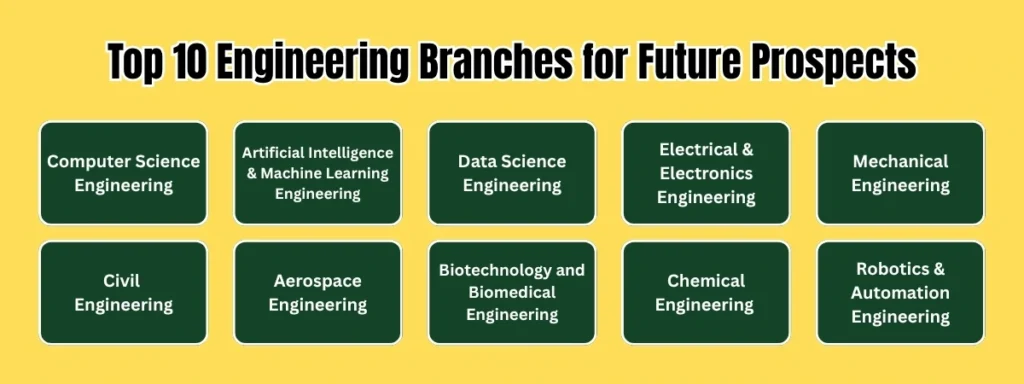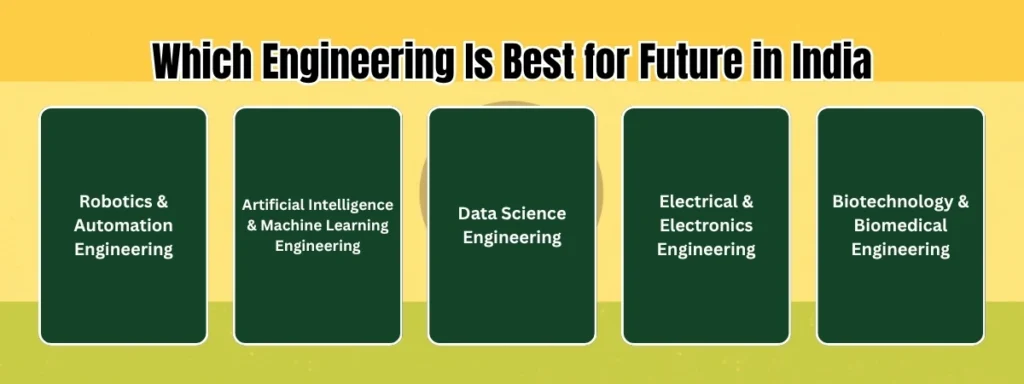Engineering has always been the bedrock of human progress, transforming abstract scientific principles into tangible innovations that shape our world. But as we stand at the precipice of a new technological epoch defined by AI, sustainability, and interconnected systems, a critical question arises for aspiring engineers and their mentors: Which engineering branch is best for future? The answer is no longer a simple, one-size-fits-all declaration. The “best” branch is a confluence of personal aptitude, passion, and market dynamics. Choosing the right engineering branch in this decade is not just about getting a degree – it’s about selecting a field that ensures future-proof skills, high employability, global relevance, strong salary growth, and long-term career stability.
Key Highlights – Which Engineering Branch is Best for Future?
- Why Choosing the Right Engineering Branch Matters in 2026?
- Top 10 Engineering Branches for Future Prospects
- Which Engineering Is Best for Future in India
- Conclusion
- FAQs
Apply to Top European Universities
Make your application simple and stress-free with Successcribe
Get Expert Help NowWhy Choosing the Right Engineering Branch Matters in 2026?

If you are trying to understand which engineering branch is best for future, it’s important to focus on branches that remain relevant even as technology evolves. The choices students make today will decide their employability for the next 20–30 years.
- Rapid Technology Shifts: Technologies are evolving faster than educational systems. Students need to choose branches that align with future demand, not past trends.
- High Competition: India produces over 1.5 million engineers every year, making specialization and future-proof skills essential.
- Global Opportunities: Branches like AI, Data Science, Robotics, and Biotechnology open doors to global jobs in the USA, Germany, Canada, Japan, South Korea, and the EU.
- Salary Growth: New-age engineering fields are offering 30–150% higher salary packages compared to traditional streams in many sectors.
- Industry 4.0 & 5.0: Smart factories, autonomous systems, IoT, and human-AI collaboration will dominate the industrial landscape from 2025–2035.
Top 10 Engineering Branches for Future Prospects
We will analyze the future scope, opportunities, salaries, pros & cons, and industry trends for:

1. Computer Science Engineering: The Most Future-Proof Branch
When students and parents ask “which engineering branch is best for future,” Computer Science Engineering consistently emerges as the top answer due to its unmatched versatility, global demand, and adaptability across all industries. Computer Science Engineering continues to dominate as the No.1 engineering branch in the world in 2025–26. With digital transformation accelerating across every industry—healthcare, finance, education, manufacturing, energy, aviation – CSE remains the backbone of the global tech economy. CSE is not just about software development anymore. It now covers advanced fields like AI, Cloud Computing, Cybersecurity, AR/VR, Blockchain, Quantum Computing, IoT, 5G/6G, full-stack development, and autonomous systems.
This makes CSE the most flexible, high-paying, future-ready, and globally in-demand engineering branch for the coming decade.
Why CSE Is the Best Engineering Branch for Future
- Highest employability among all engineering branches: According to multiple reports (NASSCOM 2024, WEF 2025), 70% of new engineering jobs till 2035 will be from CSE and related fields.
- Fastest salary growth: CSE salaries have increased by 20–45% since 2022, with projections showing a 12% yearly rise till 2030.
- Global demand exceeds supply: Countries including the USA, Canada, Germany, Japan, UK, and Singapore have severe shortages of software engineers, cybersecurity experts, AI engineers, and cloud specialists.
- Remote work-friendly: 60–70% of tech roles allow hybrid or remote work, giving students more flexibility.
- Applicable in every industry: From fintech apps to self-driving cars to healthcare AI to e-commerce, computer engineers are required everywhere.
Future Scope of CSE
CSE will expand through emerging technologies:
- AI & Machine Learning: Projected to grow 37% annually till 2030.
- Cybersecurity: Over 3.5 million jobs will remain unfilled globally in 2026.
- Cloud Computing: India’s cloud market will reach USD 25 billion by 2030.
- 6G, IoT & Embedded Computing: Smart cities, electric vehicles, and Industry 5.0 systems will need millions of CSE graduates.
- Quantum Computing: Expected to create $6 trillion impact globally by 2035.
Job Roles After CSE
| Job Role | Description | Demand Outlook (2030) |
| Software Developer | Builds applications & systems | Very High |
| AI/ML Engineer | AI-based tools, models, automation | Extremely High |
| Data Engineer | Manages data pipelines & frameworks | Very High |
| Cybersecurity Analyst | Protects systems from cyber threats | Extremely High |
| Cloud Architect | Designs cloud infrastructure | Very High |
| Full Stack Developer | End-to-end web applications | High |
| Blockchain Developer | Crypto, DeFi, security systems | High |
| Mobile App Developer | Android/iOS solutions | High |
| DevOps Engineer | Automation & CI/CD | Very High |
| Quantum Computing Researcher | Quantum algorithms & systems | Emerging |
| AR/VR Developer | Virtual worlds, simulations | High |
Salary Insights
| Experience Level | India (Annual) | USA (Annual) | Global Average |
| Entry Level (0-2 years) | ₹4-8 lakhs | $75,000-$95,000 | $60,000-$80,000 |
| Mid Level (3-6 years) | ₹12-25 lakhs | $110,000-$145,000 | $90,000-$120,000 |
| Senior Level (7-12 years) | ₹30-60 lakhs | $160,000-$220,000 | $130,000-$180,000 |
| Lead/Architect (12+ years) | ₹50 lakhs-1.5 crore | $240,000-$400,000 | $200,000-$320,000 |
Advantages
- Highest placement rates (85-95% in tier-1 colleges)
- Maximum startup opportunities and entrepreneurial potential
- Remote work flexibility and geographic independence
- Continuous learning and rapid skill evolution
- Strong global demand across all sectors
Challenges
- Intense competition with millions of CSE graduates
- Rapid technology changes requiring constant upskilling
- High stress and demanding project deadlines
- Saturated entry-level market in certain regions
- Work-life balance concerns in high-growth companies
2. Artificial Intelligence & Machine Learning Engineering (AI & ML)
A strong contender for which engineering branch is best for future is AI & ML Engineering. Artificial Intelligence and Machine Learning Engineering has quickly moved from a niche specialization to one of the fastest-growing engineering branches in the world. As we move into 2025–26, AI is no longer optional – it is the driving force behind global innovation.
From self-driving cars, robotics, drones, predictive healthcare, smart cities, fintech automation, cybersecurity, personalised education, speech & vision systems, and even space exploration, AI/ML engineers are at the center of all major technological breakthroughs. AI Engineering has been officially recognized as one of the Top 3 most in-demand skills globally (LinkedIn Future Skills Report 2025).
Why AI & ML Engineering Is One of the Best Engineering Branches for the Future
- AI is expected to create 97 million new jobs globally by 2030
- India’s AI industry will reach USD 40 billion by 2030: Driven by healthcare, banking, agriculture, manufacturing, defense & e-commerce.
- AI talent shortage is massive: Only 1 out of 5 AI jobs are filled due to lack of skilled engineers.
- AI engineers receive the highest salary packages in the tech sector: Even freshers with strong AI skills get 2–3x higher pay.
- AI powers almost every future technology: Robotics, Data Science, Cybersecurity, AR/VR, Quantum Computing → all depend on AI.
Future Scope of AI & ML Engineering
AI will dominate the upcoming decade through:
- Generative AI: Tools like ChatGPT, Gemini, Claude, and their enterprise versions will create new roles such as: AI Prompt Engineer, AI Automation Engineer, and AI Workflow Designer. The global GenAI market is expected to hit $1.3 trillion by 2032.
- Autonomous Systems: Self-driving cars, autonomous drones, and robotics rely heavily on ML algorithms.
- Computer Vision: Used in healthcare imaging, surveillance, manufacturing, and defense.
- AI in Healthcare: AI will diagnose diseases with 90% accuracy and automate 40% of clinical operations by 2030.
- AI in Finance: Fraud detection, trading bots, credit analysis, risk scoring—all automated with ML.
- AI in Education: Personalized learning platforms, AI tutors, assessment tools.
- AI in Manufacturing: Predictive maintenance, digital twins, robotics integration.
Job Roles After AI & ML Engineering
| Job Role | Description | Demand Outlook |
| AI Engineer | Builds intelligent systems | Extremely High |
| Machine Learning Engineer | ML model development | Extremely High |
| Data Scientist | Statistical modeling & insights | Very High |
| NLP Engineer | Chatbots, voice assistants | Extremely High |
| Computer Vision Engineer | Imaging & camera-based systems | Very High |
| Deep Learning Engineer | Neural networks, AI models | Extremely High |
| Robotics AI Engineer | AI-powered robots | High |
| AI Research Scientist | Advanced AI research | High |
| AI Automation Engineer | Enterprise workflows & automation | Very High |
| AI Product Manager | AI-based product design | High |
Salary Insights
| Experience Level | India (Annual) | USA (Annual) | Global Average |
| Entry Level (0-2 years) | ₹6-12 lakhs | $90,000-$120,000 | $75,000-$100,000 |
| Mid Level (3-6 years) | ₹18-35 lakhs | $130,000-$180,000 | $110,000-$150,000 |
| Senior Level (7-12 years) | ₹40-80 lakhs | $180,000-$280,000 | $150,000-$230,000 |
| Lead/Research Scientist (12+ years) | ₹70 lakhs-2 crore | $280,000-$500,000+ | $240,000-$420,000 |
Advantages:
- Among the highest-paying engineering specializations globally
- Cutting-edge work with transformative technologies
- High demand from tech giants and startups alike
- Research opportunities in academia and industry
- Significant impact potential across diverse industries
Challenges
- Requires strong mathematical and statistical foundation
- Steep learning curve and continuous skill development
- Limited entry-level positions compared to general software roles
- Need for specialized hardware (GPUs) for model training
- Ethical considerations and bias management responsibilities
Suggested Post: Masters in Artificial intelligence in USA
3. Data Science Engineering
Data Science Engineering sits at the intersection of statistics, engineering, and domain knowledge. As organisations collect vastly more data from sensors, transactions, user behaviour, and connected devices, the ability to turn raw data into actionable insight has become a strategic advantage. In 2025–26, data science is less a single job title and more a cluster of roles (data engineer, ML engineer, analytics translator, etc.) that together drive data-powered decision-making.
Why Data Science Engineering matters in 26
- Core enabler of AI and automation: While AI/ML builds models, data science prepares, validates, and interprets the data those models learn from—making it indispensable for trustworthy AI.
- Broad industry adoption: Finance, healthcare, retail, manufacturing, telecom, edtech, energy and government all depend on data science to optimize processes, reduce costs and personalise services.
- Strong demand, but mixed compensation trends: Globally, data roles remain highly paid; however, regional salary patterns are shifting (for example, median India tech pay has faced pressures in 2025 while the U.S. market has continued rising).
Growth outlook (to 2030)
- The World Economic Forum’s Future of Jobs Report 2025 highlights data- and AI-related roles among the fastest-growing job families through 2030 and flags strong demand for analytical, creative and resilience skills.
- Industry estimates and job-market trackers show demand for data roles continuing to expand through 2030, driven by investments in cloud, data platforms, GenAI adoption, and analytics-led decision-making.
Typical Job Roles in Data Science Engineering
| Role | Core Responsibility | Outlook (2030) |
| Data Scientist | Statistical modeling, predictive models, causal inference | Very High |
| Data Engineer | Building data pipelines, ETL, streaming & data warehousing | Extremely High |
| ML Engineer | Productionising ML models and MLOps | Extremely High |
| Analytics Engineer | Transforming data for analysis, BI-layer work | Very High |
| Business Intelligence (BI) Analyst | Dashboards, KPIs, business reporting | High |
| ML Researcher | New algorithms, advanced models | High (research hubs) |
| Data Product Manager | Define data-driven products & KPIs | High |
| Applied Economist / Quant | Pricing, risk, econometrics in finance/markets | High |
Salary Insights
| Experience Level | India (Annual) | USA (Annual) | Global Average |
| Entry Level (0-2 years) | ₹5-10 lakhs | $80,000-$105,000 | $65,000-$90,000 |
| Mid Level (3-6 years) | ₹15-30 lakhs | $120,000-$160,000 | $100,000-$135,000 |
| Senior Level (7-12 years) | ₹35-70 lakhs | $170,000-$240,000 | $140,000-$200,000 |
| Lead Data Scientist (12+ years) | ₹60 lakhs-1.8 crore | $250,000-$450,000 | $210,000-$380,000 |
Advantages
- High demand across all industries and sectors
- Excellent work-life balance compared to software development
- Combination of analytical and creative problem-solving
- Clear career progression with leadership opportunities
- Remote work possibilities with global companies
Challenges
- Requires strong statistical and mathematical background
- Data quality issues can limit analysis effectiveness
- Business domain knowledge often necessary for impact
- Tools and technologies evolve rapidly
- Sometimes caught between technical and business expectations
Suggested Post: Masters in Data science in USA
4. Electrical & Electronics Engineering (EEE)
Electrical & Electronics Engineering (EEE) sits at the center of the world’s energy transition, electronics revolution, and electrification of transport and industry. In 2025–26, demand for EEE graduates is being driven by three parallel megatrends: renewable energy and grid modernization, electric vehicles (EVs) and charging infrastructure, and the semiconductor/electronics push (plus increasing demand from datacentres and automation). That mix makes EEE one of the most practically impactful engineering branches for the next decade.
Why EEE matters in 2026
- India’s power system is rapidly shifting – non-fossil capacity has crossed major milestones and the country aims for a far higher renewable share by 2030, increasing demand for power-system and grid engineers.
- Renewables are expected to meet over 90% of global electricity demand growth between 2025–2030, which means strong hiring for power electronics, grid integration, storage and systems engineers.
- EV adoption and manufacturing growth in India and globally is creating large hiring pools for motor-drive designers, power-electronics engineers, battery management experts and charging-infrastructure engineers. Estimates suggest millions of new direct and indirect jobs in EV ecosystems in the coming years.
Future scope (2025–2030) – where EEE graduates will fit
- Grid modernisation & smart grids: integrating variable renewables, energy storage (batteries, pumped hydro), microgrids and demand-response systems.
- Power electronics & converters: essential for EVs, solar inverters, HVDC links and industrial motor drives.
- Energy storage & battery systems: BMS design, battery recycling, second-life systems.
- Charging infrastructure & standards: DC fast-charging networks, V2G (vehicle-to-grid) systems.
- Semiconductor & embedded systems: design and testing for power ICs, energy-efficient chips and power management units.
- High-performance computing & datacentres: power distribution, cooling electrification and UPS systems (AI datacentres will increase electricity demand).
Typical job roles
| Role | Core responsibilities | Outlook (2030) |
| Power Systems Engineer | Grid planning, protection, stability analysis | Very High |
| Power Electronics Engineer | Inverters, converters, motor drives | Extremely High |
| EV Systems Engineer | Traction motors, BMS, chargers | Extremely High |
| Controls Engineer | Control systems for industry & robotics | High |
| Substation/Protection Engineer | Relay coordination, HV systems | High |
| Renewable Integration Engineer | PV/wind integration, storage sizing | Very High |
| Electronics Design Engineer | PCB, embedded systems, power ICs | High |
| Test & Validation Engineer | Product testing, certification | High |
| Field Service Engineer | Commissioning, maintenance | High |
Salary Insights
| Experience Level | India (Annual) | USA (Annual) | Global Average |
| Entry Level (0-2 years) | ₹3.5-7 lakhs | $70,000-$85,000 | $55,000-$70,000 |
| Mid Level (3-6 years) | ₹8-18 lakhs | $95,000-$125,000 | $80,000-$105,000 |
| Senior Level (7-12 years) | ₹20-40 lakhs | $130,000-$180,000 | $110,000-$150,000 |
| Lead Engineer (12+ years) | ₹35-75 lakhs | $170,000-$250,000 | $145,000-$210,000 |
Advantages
- Diverse career options across multiple industries
- Strong job security in essential infrastructure sectors
- Opportunities in both core and software domains
- Government and private sector employment options
- Growing demand due to electrification trends
Challenges
- Often lower initial salaries compared to CSE
- May require additional certifications for specializations
- Hardware jobs less amenable to remote work
- Field work required in power and renewable energy sectors
- Slower adoption of new technologies compared to software
Suggested Post: Masters Electrical Engineering in Germany
5. Mechanical Engineering
Mechanical Engineering remains one of the broadest and most adaptable engineering branches in 2025–26. While pure “routine” manufacturing roles have matured, mechanical engineers who combine classic fundamentals (mechanics, thermodynamics, materials) with Industry 4.0 skills (automation, sensors, digital twins), EV systems, additive manufacturing, and sustainability command the best opportunities going into 2030. Despite common misconceptions, Mechanical Engineering remains a solid answer to which engineering branch is best for future, especially for engineers who combine traditional fundamentals with Industry 4.0 skills like automation, digital twins, and sustainable design.
Why Mechanical Engineering still matters
Mechanical engineers design and optimize the physical world – machines, vehicles, energy systems, HVAC, manufacturing lines, and more. That “tangible” influence means every major transition (electrification, automation, sustainable manufacturing, aerospace growth, and advanced medical devices) needs mechanical engineers deeply involved. The World Economic Forum and industry trackers list automation, sustainability engineering and advanced manufacturing among the fastest-growing job families – areas where mechanical skills are central.
Key growth drivers (2025–2030)
- Electrification & EVs – motors, thermal management, manufacturing of battery packs and drivetrains. EV supply-chain growth is creating design and testing roles for mechanical engineers.
- Additive Manufacturing (3D printing) – lightweighting, rapid prototyping and small-batch aerospace parts require mechanical design tuned for AM processes.
- Industry 4.0 / Automation – robotics, digital twins, predictive maintenance and cyber-physical systems are integrating mechanical expertise with software and data engineering.
- Aerospace & Defense – renewed aerospace manufacturing and satellite/space missions drive demand for structural, propulsion, and thermal systems engineers.
- Sustainability & Energy Transition – HVAC electrification, heat-pump tech, hydrogen systems, and energy-efficient product design open new roles.
Typical job roles & demand outlook
| Role | Core Work | Demand Outlook (2030) |
| Design Engineer (CAD/CAE) | Product design, FEA, simulation | Very High |
| Thermal/Heat Transfer Engineer | Cooling systems, HVAC, thermal management | High |
| Manufacturing/Process Engineer | Line design, lean manufacturing, automation | Ver High |
| Additive Manufacturing Engineer | AM part design, qualification | High |
| Robotics/Automation Engineer | Integrating robots, controls | Very High |
| EV Powertrain & Battery Thermal Engineer | Motor, gearbox, BMS thermal design | Extremely High |
| R&D / Materials Engineer | New materials, composites, alloys | High |
| Quality & Test Engineer | Validation, testing, certification | High |
Salary Insights
| Experience Level | India (Annual) | USA (Annual) | Global Average |
| Entry Level (0-2 years) | ₹3-6 lakhs | $68,000-$82,000 | $52,000-$68,000 |
| Mid Level (3-6 years) | ₹7-15 lakhs | $85,000-$115,000 | $72,000-$98,000 |
| Senior Level (7-12 years) | ₹18-35 lakhs | $110,000-$155,000 | $95,000-$135,000 |
| Engineering Manager (12+ years) | ₹30-65 lakhs | $150,000-$220,000 | $130,000-$190,000 |
Advantages
- Broadest engineering discipline with diverse applications
- Opportunities across manufacturing, automotive, aerospace, energy
- Core engineering principles remain relatively stable
- Combination of design, analysis, and hands-on work
- Government sector opportunities with job security
Challenges
- Lower average salaries than software disciplines in India
- Manufacturing sector growth slower than IT sector
- May require on-site presence at factories or plants
- Competition from automation reducing routine positions
- Additional courses (CAD/CAM) often necessary for employability
Suggested Post: Masters in Mechanical Engineering in Germany
6. Civil Engineering
Civil Engineering remains one of the most stable, essential, and future-secure branches of engineering. Unlike technology-based branches that shift rapidly, the demand for modern infrastructure, urban development, transportation systems, and environmental sustainability ensures that civil engineering will continue to grow strongly till 2030 and beyond.
In the decade of smart cities, climate resilience, green buildings, high-speed transportation, metro expansion, and mega infrastructure investments, civil engineers are entering one of the strongest growth phases globally.
Why Civil Engineering Still Has Massive Future Scope
- Governments worldwide are increasing infrastructure spending: Countries like India, the USA, UAE, Singapore, Germany, and Canada have announced multi-trillion-dollar investments in infrastructure till 2030.
- Urbanization continues: More than 70% of the global population will live in cities by 2050, increasing the need for sustainable housing, roads, water systems, metro lines, and smart infrastructure.
- Sustainability + climate resilience = new high-demand roles: Green buildings, energy-efficient construction, disaster-resistant structures, flood control systems, water management, and renewable energy infrastructure are emerging fields that require specialized civil engineers.
- Global engineering shortages: Countries like Canada, Germany, Australia, UK, France, Japan, and GCC nations face massive shortages of civil engineers, offering global opportunities.
Industry Growth Forecast
Global infrastructure spending is projected to reach $9 trillion annually by 2030, with developing nations accounting for significant portions. India’s National Infrastructure Pipeline plans ₹111 lakh crore ($1.4 trillion) investment through 2030 in projects spanning transportation, urban development, and energy. The smart cities mission across 100 Indian cities creates sustained demand for civil engineering expertise.
Top Job Roles in Civil Engineering
| Job Role | What They Do | Demand Outlook (2030) |
| Structural Engineer | Designs safe, strong structures | Very High |
| Construction Manager | Supervises on-site execution | Very High |
| Transportation Engineer | Designs roads, metros, highways | Extremely High |
| Geotechnical Engineer | Soil testing, foundation design | High |
| Environmental Engineer | Waste, water, pollution management | Very High |
| Water Resource Engineer | Dams, canals, irrigation, drainage | High |
| Urban Planner | Smart cities, sustainable planning | Very High |
| BIM Engineer | Digital modelling using BIM tools | Extremely High |
| Project Manager | Lead construction/infrastructure projects | High |
Salary Insights
| Experience Level | India (Annual) | USA (Annual) | Global Average |
| Entry Level (0-2 years) | ₹3-5.5 lakhs | $65,000-$78,000 | $50,000-$65,000 |
| Mid Level (3-6 years) | ₹6-14 lakhs | $80,000-$105,000 | $68,000-$90,000 |
| Senior Level (7-12 years) | ₹15-30 lakhs | $105,000-$145,000 | $90,000-$125,000 |
| Project Manager (12+ years) | ₹25-55 lakhs | $135,000-$190,000 | $115,000-$165,000 |
Advantages
- Tangible, visible impact through physical infrastructure
- Stable career with consistent government and private sector demand
- Diverse specializations from structural to environmental
- Opportunities for entrepreneurship through construction firms
- Less susceptible to automation compared to other disciplines
Challenges
- Lower initial salaries compared to software engineering in India
- Field work often required in challenging conditions
- Project-based employment can mean relocation
- Career growth sometimes requires moving into management
- Bureaucratic delays can slow project progress
Suggested Post: Masters in Civil Engineering in Germany
7. Aerospace Engineering
Aerospace Engineering in 2025 sits at an exciting intersection: traditional civil and defense aviation needs remain steady while commercial space, small-satellite constellations, private launchers, hypersonics, and advanced avionics are driving rapid innovation and hiring. The global “space economy” and aerospace M&A activity have been expanding, and governments and private companies are investing heavily in manufacturing capability, launch infrastructure, and R&D. These shifts make aerospace one of the most promising specialized engineering branches for the next decade – especially for students who combine strong fundamentals with systems-thinking and software/data skills.
Headlines
- The global space economy reached roughly $613 billion in 2024, showing robust year-over-year growth and broadening commercial opportunities.
- Aerospace engineering employment is forecast to grow around 6% (U.S. BLS projection 2024–34) – faster than average for all occupations – driven by defense, civil aviation modernization, and private-space ventures.
- India’s space economy (2025) is valued at roughly $8–8.4 billion and official targets and policy support aim to grow it substantially (estimates targeting $44–45 billion within the next decade), creating domestic aerospace and space-tech hiring surges.
Why aerospace is a forward-looking choice (2025–2035)
- Commercial space boom: Small-sat constellations, Earth-observation services, launch-on-demand, and space-enabled connectivity create a wide set of engineering problems – structural, propulsion, thermal, avionics, and systems integration. The commercial space market’s expansion translates directly to jobs in satellite design, launch vehicle subsystems, and systems engineering.
- Defense & national-security investments: Geopolitical tensions and modernization programs keep defense aerospace activity and R&D spending high, supporting jobs in missile systems, avionics, and electronic warfare.
- Aviation fleet renewal & sustainable flight: Airlines and OEMs are investing in next-gen propulsion (hybrid-electric, hydrogen), lightweight materials, and sustainable aviation fuels – areas that demand mechanical, propulsion, and materials expertise.
- Manufacturing onshore & supply-chain localization (India): Policy push and industry investments (including by global OEMs and defense suppliers expanding headcount in India) are strengthening local aerospace manufacturing and testing capabilities. Examples include multinational expansions and state-level incentives for A&D clusters.
Typical aerospace job role
| Role | What they do |
| Aerospace Design Engineer | Structural design, CAD/FEA for airframes & satellites. |
| Propulsion Engineer | Rocket/jet engine design, combustion, turbomachinery. |
| Systems Engineer | Integrates subsystems, requirements & verification. |
| Avionics Engineer | Flight-control electronics, embedded systems, sensors. |
| Flight Test Engineer | Test planning, instrumentation, data analysis. |
| Thermal Engineer | Thermal control for spacecraft & aircraft components. |
| Manufacturing & Quality Engineer | Production processes, composites, inspection & certification. |
| Mission Operations / Satellite Ops | Ground segment operations, telemetry, payload control. |
| Controls & Guidance Engineer | Guidance, navigation & control (GNC) algorithms. |
| Propulsion Test Technician | Test rigs, hot-fire testing, safety compliance. |
Salar Insights
| Experience Level | India (Annual) | USA (Annual) | Global Average |
| Entry Level (0-2 years) | ₹4-8 lakhs | $75,000-$92,000 | $60,000-$78,000 |
| Mid Level (3-6 years) | ₹10-20 lakhs | $98,000-$130,000 | $85,000-$112,000 |
| Senior Level (7-12 years) | ₹22-45 lakhs | $125,000-$175,000 | $108,000-$152,000 |
| Lead Engineer (12+ years) | ₹40-80 lakhs | $165,000-$240,000 | $145,000-$210,000 |
Advantages
- Working on cutting-edge, inspirational projects
- High intellectual challenge and satisfaction
- Growing private sector opportunities globally
- Excellent work-life balance in research organizations
- Prestige and specialized expertise
Challenges
- Limited positions compared to mainstream engineering
- Often requires advanced degrees for specialized roles
- Concentrated in specific geographic locations (Bangalore, Thiruvananthapuram for India)
- Long project timelines testing patience
- Security clearances may be required for defense work
Suggested Post: Masters in Aerospace Engineering in Germany
8. Biotechnology and Biomedical Engineering
For students asking which engineering branch is best for future healthcare innovation, Biotechnology and Biomedical Engineering merge biology with technology to solve humanity’s greatest challenges, from genetic therapies to advanced medical devices. Among the most powerful and fast-growing engineering fields, Biotechnology and Biomedical Engineering stand out for their direct impact on human life. They are at the heart of the global healthcare revolution, merging biology with cutting-edge technology to solve some of humanity’s greatest challenges. The global biotechnology market is expected to reach USD 3.44 trillion by 2030, while the biomedical engineering market is growing at a rate of 12–15% annually, driven by medical device innovation and rising demand for advanced healthcare solutions.
Why Biotechnology & Biomedical Engineering Are the Best for the Future
- Dominant fields in healthcare, genetics, and medical research
- High global demand for biotech and biomedical professionals
- Involvement in vaccine development, genetic engineering, stem-cell therapy
- Increasing usage of AI and automation in healthcare diagnostics
- Massive investments in biotech startups and medical device companies
- Strong opportunities abroad (US, Germany, UK, Canada)
- High-paying roles in pharma, biopharma, hospitals, R&D labs
- Long-term stability because healthcare will always grow
Difference Between Biotechnology & Biomedical Engineering
| Feature | Biotechnology | Biomedical Engineering |
| Focus | Biological processes, genetics, microbiology | Medical devices, imaging, and healthcare technology |
| Industries | Pharma, biotech labs, vaccines, agriculture | Hospitals, medical device companies |
| Skills Needed | Molecular biology, bioinformatics | Electronics, mechanics, biomedical systems |
| Popular Roles | Research Scientist, Bioprocess Engineer | Biomedical Engineer, Clinical Engineer |
Salary Insights
| Experience Level | India (Annual) | USA (Annual) | Global Average |
| Entry Level (0-2 years) | ₹3.5-7 lakhs | $68,000-$85,000 | $55,000-$72,000 |
| Mid Level (3-6 years) | ₹8-18 lakhs | $90,000-$122,000 | $78,000-$105,000 |
| Senior Level (7-12 years) | ₹20-42 lakhs | $115,000-$165,000 | $100,000-$145,000 |
| Research Scientist (12+ years) | ₹35-75 lakhs | $155,000-$230,000 | $135,000-$200,000 |
Advantages
- Direct positive impact on human health and quality of life
- Rapidly growing field with significant research opportunities
- Combination of biology and engineering creates unique skillset
- Opportunities in pharmaceuticals, medical devices, and research
- Less prone to automation due to complexity
Challenges
- Often requires postgraduate education for advanced positions
- Long regulatory approval timelines for products
- Laboratory work can be repetitive and time-intensive
- Initial salaries lower than software engineering in India
- Ethical considerations in genetic engineering and human trials
Suggested Post: Masters in Biotechnology in USA
9. Chemical Engineering
Chemical Engineering is one of the most versatile and evergreen engineering branches that continues to evolve with global industrial demands. In 2025–26, its scope has expanded far beyond traditional petrochemicals and fertilizers. Today, chemical engineers are leading innovation in renewable energy, nanotechnology, green hydrogen, pharmaceuticals, battery technology, sustainable materials, and environmental engineering.
With the world shifting towards clean energy, electric mobility, biofuels, and sustainable manufacturing, chemical engineers are in massive demand worldwide.
Why Chemical Engineering Is One of the Best for the Future
- Required in almost every major industry: energy, pharma, food, materials, environment
- High-paying jobs both in India and abroad
- Central role in green hydrogen, carbon capture, and waste-to-energy projects
- Strong research and innovation-driven opportunities
- Chemical industry contributes 7% to India’s GDP
- Massive scope in the Middle East (UAE, Saudi Arabia, Qatar), Europe, and USA
- Always in demand regardless of economic shifts because chemicals are essential to all manufacturing sectors
Industry Growth Trends
| Sector | Growth Rate | Insights |
| Specialty Chemicals | 12–14% CAGR | Driven by cosmetics, electronics & advanced materials |
| Green Hydrogen | 28–32% CAGR | Huge global investments, India building hydrogen hubs |
| Battery & Energy Storage | 25% CAGR | Chemical engineers needed for EV battery materials |
| Pharma & Biotech | 10–12% CAGR | India is the world’s pharmacy, huge production demand |
| Petrochemicals | 6–8% CAGR | Still stable due to plastics, fuels, polymers |
Salary Insights
| Experience Level | India (Annual) | USA (Annual) | Global Average |
| Entry Level (0-2 years) | ₹3.5-6.5 lakhs | $70,000-$86,000 | $58,000-$73,000 |
| Mid Level (3-6 years) | ₹7-16 lakhs | $88,000-$118,000 | $76,000-$102,000 |
| Senior Level (7-12 years) | ₹18-35 lakhs | $115,000-$160,000 | $100,000-$140,000 |
| Process Manager (12+ years) | ₹30-65 lakhs | $145,000-$210,000 | $128,000-$185,000 |
Advantages
- Diverse industries from pharmaceuticals to energy
- Strong demand in manufacturing and processing industries
- Combination of theoretical knowledge and practical application
- Opportunities in research, production, and consulting
- Government PSU positions with job security
Challenges
- Often requires working in industrial locations away from metros
- Safety considerations and hazardous material handling
- Industry slowdowns can affect employment
- Initial salaries lower than IT sector in India
- Physical plant work environment may not suit everyone
Suggested Post: Chemical Engineering in USA
10. Robotics & Automation Engineering
Robotics & Automation Engineering is one of the fastest-growing and most future-proof engineering branches in the world. As industries shift toward Industry 4.0 and Industry 5.0, robotics engineers are becoming essential across manufacturing, logistics, healthcare, defense, automotive, and even home automation.
In 2025–26, robotics is no longer limited to industrial robots. New advancements include:
- Humanoid robots (Tesla Optimus, Figure 01, Agility Robotics)
- AI-powered autonomous robots
- Robotic surgery systems (Da Vinci Robot)
- Agricultural robots
- Military drones & UAVs
- Self-driving vehicles & robotics sensors
- Service robots for households, hospitals, hotels
The global robotics market is expected to reach USD 330+ billion by 2030, growing at a massive 17–22% CAGR, making it one of the best engineering branches for the future.
Why Robotics & Automation Engineering Is Among the Best for 2025–2035
- Industries are replacing repetitive human tasks with robots
- Strong demand in automotive, manufacturing, electronics, healthcare, defense
- Core branch for the future of AI + engineering
- One of the highest-paying engineering specialties globally
- Opportunities to work on cutting-edge fields: drones, prosthetics, exoskeletons, humanoids
- Heavy international demand in US, Germany, Japan, South Korea
Industry Growth Trends
| Industry | Growth Rate | Key Drivers |
| Industrial Robots | 15–18% CAGR | Smart factories + automation |
| Medical Robotics | 20–25% CAGR | Robotic surgeries increasing |
| Service Robots | 18–22% CAGR | Hotels, hospitals, homes |
| Drones & UAVs | 22–27% CAGR | E-commerce, defense, agriculture |
| Autonomous Vehicles | 25%+ CAGR | Self-driving ecosystems |
Robotics is shaping the next decade across every sector.
Top Job Roles & Salaries
| Job Role | Salary in India (₹ LPA) | Global Salary (USD) |
| Robotics Engineer | 6–14 LPA | $85,000–140,000 |
| Automation Engineer | 5–12 LPA | $75,000–120,000 |
| Drone Engineer | 6–15 LPA | $90,000–145,000 |
| Control Systems Engineer | 6–12 LPA | $85,000–130,000 |
| Robot Programmer | 5–10 LPA | $70,000–110,000 |
| Robotic Surgery Engineer | 10–20 LPA | $120,000–180,000 |
| Autonomous Vehicle Engineer | 12–25 LPA | $130,000–200,000 |
| Mechatronics Engineer | 5–12 LPA | $75,000–120,000 |
| AI Robotics Engineer | 12–30 LPA | $150,000–220,000 |
Suggested Post: MSc Robotics in UK
Which Engineering Is Best for Future in India

India is entering a decade of rapid technological growth, driven by digital transformation, AI adoption, electric mobility, renewable energy, and healthcare innovation. As a result, the engineering branches that align with these high-growth sectors offer the strongest career opportunities for 2025–2035.
Top Engineering Branches with the Best Future in India
Computer Science Engineering (CSE) – The backbone of India’s IT dominance, offering unmatched job diversity in software, cloud computing, cybersecurity, and AI.
- Artificial Intelligence & Machine Learning – India is set to become a global AI hub, creating massive demand for AI engineers across industries.
- Data Science & Big Data Engineering – Every Indian company—from BFSI to e-commerce—needs data specialists to drive decision-making and automation.
- Electrical & Electronics Engineering (EEE) – The rise of electric vehicles, smart grids, solar power, and semiconductor manufacturing makes EEE one of India’s most future-proof fields.
- Robotics & Automation Engineering – With “Make in India” and Industry 4.0, factories and logistics companies are adopting large-scale automation.
- Biotechnology & Biomedical Engineering – India’s booming healthcare, pharma, genetic research, and medical device industries offer high-growth, research-driven careers.
Why These Branches Are the Best for India’s Future?
- They match the fastest-growing sectors of the Indian economy
- They offer excellent starting salaries and global career paths
- Skills are future-proof, meaning long-term job security
- High demand across startups, MNCs, manufacturing, healthcare, and government projects
These fields match India’s economic growth sectors (IT, AI, automation, healthcare, EVs, renewable energy).
Conclusion
The debate over which engineering branch is best for future careers has shifted from a single answer to recognizing that multiple branches – CSE, AI, Data Science, EEE, Robotics, and Biotechnology – offer exceptional long-term prospects depending on individual interests. From 2025 to 2035, the engineering landscape will be shaped by AI, robotics, data, biotechnology, clean energy, and digital transformation. However, every branch is valuable for students who align their skills with industry needs. Engineering is not about choosing “easy” or “popular” – it is about selecting the branch where your interest + future scope + required skills meet.
FAQs
Which engineering branch is best for the future?
The top future-proof branches are AI & ML, Data Science, Robotics, CSE, Biotechnology, EEE, and Chemical Engineering.
Which engineering has the highest salary in 2025?
AI & Machine Learning Engineering and Data Science Engineering offer the highest salaries globally.
Which engineering is best for future in India?
In India, the best branches for the next decade include CSE, AI & ML, Data Science, EEE (EVs), Robotics, and Biotechnology.
Is CSE still the best branch?
Yes, CSE remains one of the most stable and highest-paying branches due to demand in software, cloud, cybersecurity, and AI.
Which engineering is best for jobs abroad?
Computer Science, AI/ML, Robotics, Aerospace, Biotechnology, and Chemical Engineering are the most in-demand internationally.
Related Post
Best medical courses in the World
Jobs and salary after mba in UK
Highest paying MBA specialization
Top countries for highest MBA salaries














